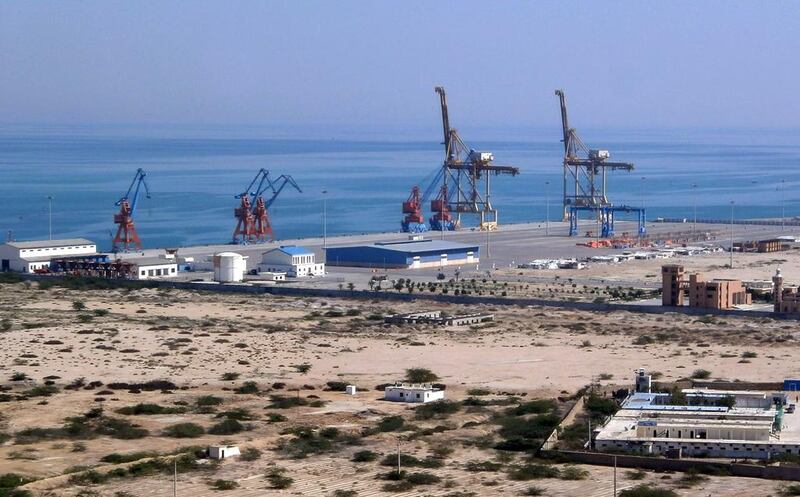Iran has energy. Its neighbour Pakistan wants energy. Their efforts to work out a deal have for years been stymied by foreign powers, but now they are trying a new approach.
Last month, Pakistan proposed an alternative gas import plan from Iran amid the lingering threat of sanctions from the United States against the $7.5 billion Iran-Pakistan (IP) gas pipeline project.
The new plan involves conversion of natural gas into liquefied natural gas (LNG) and use of Oman’s LNG terminal to import gas from Iran.
Pakistan’s oil minister, Shahid Khaqan Abbasi, met Iranian authorities in Tehran late last month and offered an LNG import plan that would ultimately shelve the IP gas pipeline project.
Under the new plan, Iran would convert natural gas into LNG then export it to Pakistan by using the terminal facility of Oman, which has already signed a deal with Iran for the purchase of about $60bn worth of natural gas over the next 25 years.
An LNG terminal has also been proposed to be set up at Gwadar port in south-western Balochistan province bordering Iran, and an LNG pipeline from Gwadar would be laid to Nawabshah town in southern Sindh province. The Gwadar-Nawabshah pipeline would also be extended by 71 kilometres towards the Iranian border for transportation of gas under the IP pipeline project, provided the US sanctions against Iran are lifted.
The much-delayed IP gas pipeline project has virtually died after Pakistan failed to commission it by the scheduled time period owing to threats of possible sanctions by the US.
Under the IP contract, Pakistan is bound to pay a penalty if it fails to complete the construction of its portion of the pipeline by December 31. Iran has already completed the section of pipeline on its territory.
Formal inauguration of the IP pipeline project by Islamabad and Tehran last year raised eyebrows in Washington and the US state department spokeswoman Victoria Nuland told reporters at the time: “We have also been working on alternative projects. We’ve heard this pipeline announced 10 to 15 times before. If this [IP pipeline] project goes forward we have serious concerns that sanctions will be triggered.”
The alternative project that the US favours for Pakistan is the proposed Turkmenistan-Afghanistan-Pakistan-India (Tapi) gas pipeline. Although Islamabad believes that the alternative LNG pipeline is a separate project having no links with the IP pipeline, the US wants Pakistan to abandon the IP project and go ahead with the Tapi pipeline.
The IP pipeline is strongly opposed by the US, while it is supported by Russia and China. Similarly, the US-backed Tapi pipeline is opposed by Russia. India had to withdraw from the Iran pipeline project in 2009 under US pressure. The international financial institutions have been reluctant to sanction funds for Pakistan for the IP project because of sanctions on Iran. The US did not exempt the IP project from the sanctions despite Iran’s nuclear deal with western nations in Geneva last year.
What seems behind the virtual demise of the strategic IP pipeline? It was geopolitics and corporate interests that ultimately halted this project. Turkmenistan’s Daulatabad fields are estimated to have gas reserves of 159 trillion cubic feet. The US energy giant Unocal has been active to lead efforts to corner the Caspian wealth through a safer and shorter route from Central Asia to the world markets. Hence, the US always supported the Tapi pipeline traversing Afghan territory. But the volatile security situation in war-torn Afghanistan has so far ensured the failure of the project.
On the other hand, Russia opposed the construction of the Tapi pipeline because it wants Turkmenistan’s gas to be firmly under its control. Turkmenistan currently ships the bulk of its gas exports to Ukraine via a pipeline controlled by the Russian gas giant Gazprom. Moscow, however, fully backed the construction of the IP pipeline to meet the energy needs of south and west Asia.
The IP pipeline could prove an energy lifeline for Pakistan because it would initially transfer 30 million cubic metres of gas per day. The country currently faces an energy emergency. There are prolonged electricity blackouts from eight to 14 hours in urban and rural areas of the country. The acute gas shortage has not only made the lives of 180 million people miserable in winter, but it has also adversely affected the industrial output. The country faces a daily shortage of about 2 billion cubic feet per day of natural gas.
Islamabad has actually offered the alternative LNG pipeline plan to avert the penalty of $3 million per day under the IP contract. The Pakistani government has already approved construction of 700km Gwadar-Nawabshah pipeline to transport LNG. An LNG terminal at Gwadar port would have the capacity to handle up to 1 billion cubic feet per day of the fuel. Chinese, Japanese and Russian companies have shown interest in building the LNG terminal and LNG pipeline from Nawabshah to Gwadar that would cost $3bn. The pipeline would also facilitate the IP pipeline project if international sanctions on Tehran are lifted.
Given China’s growing stakes in Gwadar, it is expected to be the strongest contender in the LNG terminal and the Nawabshah-Gwadar pipeline projects, both of immense geopolitical importance. But will the proposed LNG pipeline meet the same fate of the IP pipeline?
The IP versus Tapi fight among the big powers ultimately forced Pakistan, India and Iran to abandon the pipeline project. The IP pipeline episode debunks the hard geopolitical reality that whatever Pakistan’s interests or plans for energy security, things will move according to the big powers’ interests. Like the IP pipeline, the proposed LNG pipeline project may also become a casualty of geopolitics.
Syed Fazl-e-Haider is a development analyst in Pakistan. His books include The Economic Development of Balochistan
Follow The National's Business section on Twitter





